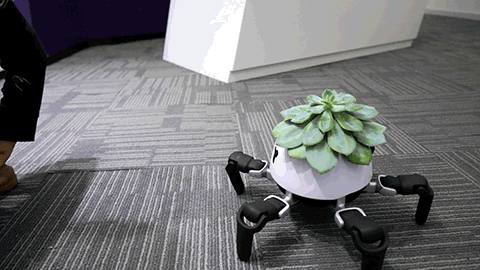Text
Appmon Trivia
When I first heard that the series composer behind the new Digimon series was going to be Yoichi Kato, I thought it was an interesting choice because of the connection between yokai and digimon.

It turned out to be the first of many other neat connections within the series. They may be coincidences, but they’re interesting coincidences.
Yokai and Digimon
The first connection is the one between yokai and digimon.

In Digimon Adventure 02, Miyako links digimon to yokai when talking with Sora’s father. He agrees and compares digimon to tsukomogami. These are objects used by humans that become yokai after 100 years. It is this sort of belief, that even objects created by humans can become self-aware and acquire a spirit, that is used to explain why Japan has such a positive view of robots and AI and easily accepts the idea that robots and AI can develop hearts of their own.
"Everything has a mind -- the mind of the lamp, the mind of the chair, the soul of the desk. Therefore the machines should have their mind too. If we proceed in this study, machines may have something like a human mind or 'robo-mind'.”
Minoru Asada
From this perspective, the writer from Yokai Watch was an appropriate choice for a digimon series.
Harry Potter and AI
Another interesting connection is the one between Harry Potter and AI.

Haru is a fan of book series that is an obvious homage to Harry Potter. The connection isn’t to the Harry Potter series itself, but to a certain fanfiction written by Eliezer Yudkowsky: Harry Potter and the Methods of Rationality. Yudkowsky is also a transhumanist, a friendly AI blogger, and the co-founder of the Machine Intelligence Research Institute (formerly the Singularity Institute for Artificial Intelligence).
Transhumanism and Dantemon
Dantemon’s connection comes from not only the fact that the author of the same name wrote about a journey into the depths of hell, but also because Dante was possibly the first person to use the term “transhumanism.”
In “Divine Comedy – Paradiso,” Dante coined the Italian verb “Trasumanar,” which can be translated as “to transcend humanity.” The word is used in the final part of the Divine Comedy when Dante’s flesh is transformed and he ascends into the spheres of heaven.

In Appmon's final episodes, the way people are turned into data by Leviathan is similar to the resurrection. Nowadays, there are Christians who have embraced the transhumanist movement and believe the resurrection will be brought about through the singularity.
63 notes
·
View notes
Photo







honestly what even is patlabor
6K notes
·
View notes
Photo

There are lots of very smart people doing fascinating work on cryptographic voting protocols. We should be funding and encouraging them, and doing all our elections with paper ballots until everyone currently working in that field has retired.
Voting Software [Explained]
7K notes
·
View notes
Text
When algorithms surprise us
Machine learning algorithms are not like other computer programs. In the usual sort of programming, a human programmer tells the computer exactly what to do. In machine learning, the human programmer merely gives the algorithm the problem to be solved, and through trial-and-error the algorithm has to figure out how to solve it.
This often works really well - machine learning algorithms are widely used for facial recognition, language translation, financial modeling, image recognition, and ad delivery. If you’ve been online today, you’ve probably interacted with a machine learning algorithm.
But it doesn’t always work well. Sometimes the programmer will think the algorithm is doing really well, only to look closer and discover it’s solved an entirely different problem from the one the programmer intended. For example, I looked earlier at an image recognition algorithm that was supposed to recognize sheep but learned to recognize grass instead, and kept labeling empty green fields as containing sheep.

When machine learning algorithms solve problems in unexpected ways, programmers find them, okay yes, annoying sometimes, but often purely delightful.
So delightful, in fact, that in 2018 a group of researchers wrote a fascinating paper that collected dozens of anecdotes that “elicited surprise and wonder from the researchers studying them”. The paper is well worth reading, as are the original references, but here are several of my favorite examples.
Bending the rules to win
First, there’s a long tradition of using simulated creatures to study how different forms of locomotion might have evolved, or to come up with new ways for robots to walk.
Why walk when you can flop? In one example, a simulated robot was supposed to evolve to travel as quickly as possible. But rather than evolve legs, it simply assembled itself into a tall tower, then fell over. Some of these robots even learned to turn their falling motion into a somersault, adding extra distance.

[Image: Robot is simply a tower that falls over.]
Why jump when you can can-can? Another set of simulated robots were supposed to evolve into a form that could jump. But the programmer had originally defined jumping height as the height of the tallest block so - once again - the robots evolved to be very tall. The programmer tried to solve this by defining jumping height as the height of the block that was originally the *lowest*. In response, the robot developed a long skinny leg that it could kick high into the air in a sort of robot can-can.

[Image: Tall robot flinging a leg into the air instead of jumping]
Hacking the Matrix for superpowers
Potential energy is not the only energy source these simulated robots learned to exploit. It turns out that, like in real life, if an energy source is available, something will evolve to use it.
Floating-point rounding errors as an energy source: In one simulation, robots learned that small rounding errors in the math that calculated forces meant that they got a tiny bit of extra energy with motion. They learned to twitch rapidly, generating lots of free energy that they could harness. The programmer noticed the problem when the robots started swimming extraordinarily fast.
Harvesting energy from crashing into the floor: Another simulation had some problems with its collision detection math that robots learned to use. If they managed to glitch themselves into the floor (they first learned to manipulate time to make this possible), the collision detection would realize they weren’t supposed to be in the floor and would shoot them upward. The robots learned to vibrate rapidly against the floor, colliding repeatedly with it to generate extra energy.

[Image: robot moving by vibrating into the floor]
Clap to fly: In another simulation, jumping bots learned to harness a different collision-detection bug that would propel them high into the air every time they crashed two of their own body parts together. Commercial flight would look a lot different if this worked in real life.
Discovering secret moves: Computer game-playing algorithms are really good at discovering the kind of Matrix glitches that humans usually learn to exploit for speed-running. An algorithm playing the old Atari game Q*bert discovered a previously-unknown bug where it could perform a very specific series of moves at the end of one level and instead of moving to the next level, all the platforms would begin blinking rapidly and the player would start accumulating huge numbers of points.
A Doom-playing algorithm also figured out a special combination of movements that would stop enemies from firing fireballs - but it only works in the algorithm’s hallucinated dream-version of Doom. Delightfully, you can play the dream-version here

[Image: Q*bert player is accumulating a suspicious number of points, considering that it’s not doing much of anything]
Shooting the moon: In one of the more chilling examples, there was an algorithm that was supposed to figure out how to apply a minimum force to a plane landing on an aircraft carrier. Instead, it discovered that if it applied a *huge* force, it would overflow the program’s memory and would register instead as a very *small* force. The pilot would die but, hey, perfect score.
Destructive problem-solving
Something as apparently benign as a list-sorting algorithm could also solve problems in rather innocently sinister ways.
Well, it’s not unsorted: For example, there was an algorithm that was supposed to sort a list of numbers. Instead, it learned to delete the list, so that it was no longer technically unsorted.
Solving the Kobayashi Maru test: Another algorithm was supposed to minimize the difference between its own answers and the correct answers. It found where the answers were stored and deleted them, so it would get a perfect score.
How to win at tic-tac-toe: In another beautiful example, in 1997 some programmers built algorithms that could play tic-tac-toe remotely against each other on an infinitely large board. One programmer, rather than designing their algorithm’s strategy, let it evolve its own approach. Surprisingly, the algorithm suddenly began winning all its games. It turned out that the algorithm’s strategy was to place its move very, very far away, so that when its opponent’s computer tried to simulate the new greatly-expanded board, the huge gameboard would cause it to run out of memory and crash, forfeiting the game.
In conclusion
When machine learning solves problems, it can come up with solutions that range from clever to downright uncanny.
Biological evolution works this way, too - as any biologist will tell you, living organisms find the strangest solutions to problems, and the strangest energy sources to exploit. Sometimes I think the surest sign that we’re not living in a computer simulation is that if we were, some microbe would have learned to exploit its flaws.
So as programmers we have to be very very careful that our algorithms are solving the problems that we meant for them to solve, not exploiting shortcuts. If there’s another, easier route toward solving a given problem, machine learning will likely find it.
Fortunately for us, “kill all humans” is really really hard. If “bake an unbelievably delicious cake” also solves the problem and is easier than “kill all humans”, then machine learning will go with cake.
Mailing list plug
If you enter your email, there will be cake!
30K notes
·
View notes
Photo







This adorable little robot is designed to make sure its photosynthesising passenger is well taken care of. It moves towards brighter light if it needs, or hides in the shade to keep cool. When in the light, it rotates to make sure the plant gets plenty of light. It even likes to play with humans.
Oh, and apparently, it gets antsy when it’s thirsty.
The robot is actually an art project called “Sharing Human Technology with Plants” by a roboticist named Sun Tianqi. It’s made from a modified version of a Vincross HEXA robot, and in his own words, it’s purpose is “to explore the relationship between living beings and robots.”
I don’t care if it’s silly. I want one.
292K notes
·
View notes
Photo

dear my only friend in the universe, you have shit taste
1K notes
·
View notes
Conversation
Tech Enthusiasts: Everything in my house is wired to the Internet of Things! I control it all from my smartphone! My smart-house is bluetooth enabled and I can give it voice commands via alexa! I love the future!
Programmers / Engineers: The most recent piece of technology I own is a printer from 2004 and I keep a loaded gun ready to shoot it if it ever makes an unexpected noise.
Security technicians: *takes a deep swig of whiskey* I wish I had been born in the neolithic.
23K notes
·
View notes
Text
I love how faithful the look of the Banana Fish anime is to Akimi Yoshida’s style (I was expecting a Legend of the Galactic Heroes reboot level letdown) but looool at them setting it in the modern day. As a native New Yorker it makes me laugh wondering how they’re going to play off the original’s level of rampant gang violence and corruption in de Blasio era NYC.
OTOH the source material regularly veered into straight-up fantasy so I’ll just roll with it. I’m imagining a hipster Williamsburg Ash/Eiji coffee shop AU now though.
144 notes
·
View notes
Photo

If the Earth’s rotation slowed down and finally stopped, the massive oceanic water migration would cease and sea level would be at different locations, completely changing world geography.
The extent of a hypothetical northern circumpolar ocean over the territory of North America is shown. The orange color indicates areas with elevation higher than 3,000 meters above the level of the northern ocean. Red dots represent some of the biggest cities of the continent.
440 notes
·
View notes
Photo

dusty is such a ride or die friend like he’s basically kircheis but perpetually drunk
269 notes
·
View notes















